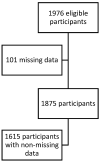Impacts of Tooth Loss on OHRQoL in an Adult Population in Cape Town, South Africa
- PMID: 34066645
- PMCID: PMC8125865
- DOI: 10.3390/ijerph18094989
Impacts of Tooth Loss on OHRQoL in an Adult Population in Cape Town, South Africa
Abstract
(1) Background: Tooth loss is an important component of the global burden of oral disease, greatly reducing the quality of life of those affected. Tooth loss can also affect diet and subsequent incidences of lifestyle diseases, such as hypertension and metabolic syndromes. This study aimed to evaluate the oral health-related quality of life (OHRQoL) score using the oral impacts on daily performance (OIDP) index in relation to tooth loss patterns among adults. (2) Methods: From 2014 to 2016, a cross-sectional study was conducted on adults living in Bellville South, Cape Town, South Africa. The OHRQoL measure was used to evaluate the impact of tooth loss. (3) Results: A total of 1615 participants were included, and 143 (8.85%) had at least one impact (OIDP > 0). Males were less likely to experience at least one impact compared to the females, OR=0.6, 95% C.I.: 0.385 to 0.942, p = 0.026. Those participants who did not seek dental help due to financial constraints were 6.54 (4.49 to 9.54) times more likely to experience at least one impact, p < 0.001. (4) Conclusions: Tooth loss did not impact the OHRQoL of these subjects. There was no difference in the reported odds for participants experiencing at least one oral impact with the loss of their four anterior teeth, the loss of their posterior occlusal pairs, or the loss of their other teeth.
Keywords: adults; noncommunicable diseases; quality of life; self-concept; tooth loss.
Conflict of interest statement
The authors declare no conflict of interest. The funders had no role in the design of the study; in the collection, analyses, or interpretation of data; in the writing of the manuscript, or in the decision to publish the results.
Figures
Similar articles
-
Is reduced dentition with and without dental prosthesis associate with oral health-related quality of life? A cross-sectional study.Health Qual Life Outcomes. 2019 May 3;17(1):79. doi: 10.1186/s12955-019-1149-2. Health Qual Life Outcomes. 2019. PMID: 31053080 Free PMC article.
-
Impact of tooth loss related to number and position on oral health quality of life among adults.Health Qual Life Outcomes. 2014 Nov 30;12:165. doi: 10.1186/s12955-014-0165-5. Health Qual Life Outcomes. 2014. PMID: 25433483 Free PMC article.
-
Oral impacts on daily performance in Turkish adults attending a dental school.J Contemp Dent Pract. 2014 Jan 1;15(1):92-8. doi: 10.5005/jp-journals-10024-1494. J Contemp Dent Pract. 2014. PMID: 24939272
-
Retention of Teeth and Oral Health-Related Quality of Life.J Dent Res. 2016 Nov;95(12):1350-1357. doi: 10.1177/0022034516657992. Epub 2016 Jul 28. J Dent Res. 2016. PMID: 27466396 Review.
-
The multifaceted impact of missing teeth on general health: A narrative review.Folia Med Cracov. 2024 Jun 30;64(1):25-37. doi: 10.24425/fmc.2024.150139. Folia Med Cracov. 2024. PMID: 39254579 Review.
Cited by
-
The association between dental caries, periodontal diseases, and tooth loss with diabetes mellitus among the elderly population.J Diabetes Metab Disord. 2024 May 4;23(1):1371-1380. doi: 10.1007/s40200-024-01434-2. eCollection 2024 Jun. J Diabetes Metab Disord. 2024. PMID: 38932804 Free PMC article.
-
Evaluation of the Impact of Oral Health on the Daily Activities of Users of the National Health System.Int J Environ Res Public Health. 2024 Jan 14;21(1):92. doi: 10.3390/ijerph21010092. Int J Environ Res Public Health. 2024. PMID: 38248555 Free PMC article.
-
Dental caries and oral health-related quality of life in Preschoolers - introducing the Swedish version of the early childhood oral health impact scale (ECOHIS).Acta Odontol Scand. 2024 Mar 26;83:47-53. doi: 10.1080/00016357.2023.2287235. Acta Odontol Scand. 2024. PMID: 38032108 Free PMC article.
-
Reliability generalization meta-analysis of Cronbach's alpha of the oral impacts on daily performance (OIDP) questionnaire.BMC Oral Health. 2025 Feb 11;25(1):220. doi: 10.1186/s12903-025-05496-3. BMC Oral Health. 2025. PMID: 39934795 Free PMC article.
References
-
- Martins-Júnior P.A., Marques L.S. Clinical implications of early loss of a lower deciduous canine. Int. J. Orthod. 2012;23:23–27. - PubMed
Publication types
MeSH terms
LinkOut - more resources
Full Text Sources


